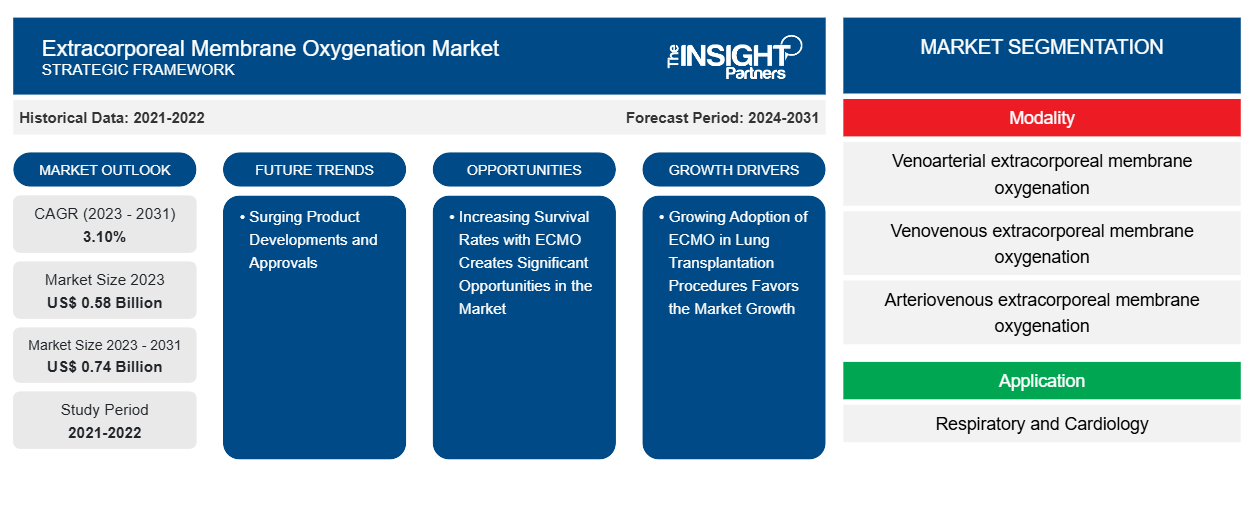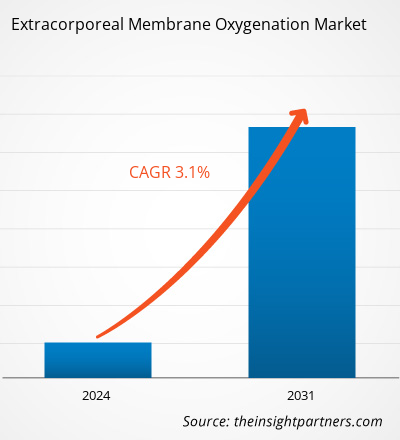The extracorporeal membrane oxygenation market size is projected to reach US$ 0.74 billion by 2031 from US$ 0.58 billion in 2023. The market is expected to register a CAGR of 3.10% during 2023–2031. Surging product developments and approvals will likely remain a key trend in the market.
Extracorporeal Membrane Oxygenation Market Analysis
In 2020, there were 89.1 million cases of ischemic stroke and 68.2 million cases of stroke worldwide. In North America, there are more cases of cardiovascular disease. Globally, heart diseases are becoming more prevalent, with developed nations seeing a sharp rise in their incidence. Changes in lifestyle and other health issues are contributing to an increase in the incidences. The market is expected to grow due to new product releases, technological advancements, and the prevalence of a large population at risk for cardiovascular illnesses. Players like Terumo Group, Medtronic Plc, MicroPort Scientific Corporation, LivaNova Plc, Nioro Medical Corporation, Getinge AB, Braile Biomedica, Fresenius Medical Care AG & Co KGaA, Abiomed Inc., and others make up the majority of the extracorporeal membrane oxygenation (ECMO) market.
Extracorporeal Membrane Oxygenation Market Overview
Respiratory failure may result from airflow obstruction brought on by chronic obstructive pulmonary disease (COPD). It is among the severe illnesses that kill millions of people worldwide. The World Health Organization (WHO) reports that 3.23 million people worldwide died from COPD in 2019, making it the third most common cause of death in 2022. Roughly 90% of deaths from COPD take place in low- and middle-income nations. In 2020, COPD ranked as the sixth most common cause of death in the United States, according to the Centers for Disease Control and Prevention (CDC). Therefore, the market for ECMOs is growing due to the rising prevalence of respiratory failures and cardiovascular diseases.
Customize This Report To Suit Your Requirement
You will get customization on any report - free of charge - including parts of this report, or country-level analysis, Excel Data pack, as well as avail great offers and discounts for start-ups & universities
Extracorporeal Membrane Oxygenation Market: Strategic Insights

-
Get Top Key Market Trends of this report.This FREE sample will include data analysis, ranging from market trends to estimates and forecasts.
Extracorporeal Membrane Oxygenation Market Drivers and Opportunities
Growing Adoption of ECMO in Lung Transplantation Procedures Favors the Market Growth
For patients with end-stage lung diseases like cystic fibrosis, idiopathic pulmonary fibrosis (IPF), and COPD, lung transplantation is a life-saving treatment option that can enhance quality of life. ECMO is a flexible instrument utilized during the preoperative, intraoperative, and postoperative stages of lung transplantation. It serves as a transitional period for patients receiving lung transplants. As a result, the use of ECMO in lung transplantation is expanding quickly to treat patients whose lung disease poses a serious threat to their lives. The Scientific Registry of Transplant Recipients (SRTR) reports that approximately 4,600 lung transplants are carried out annually worldwide, with North America accounting for 55% of those procedures. The same source states that in the US, 3,243 patients were added to the waiting list, and approximately 2,759 patients received lung transplants. Following a lung transplant, the most common cause of death is primary graft dysfunction (PGD).
Thus, PGD following lung transplantation is treated penultimately with ECMO. The overall incidence of PGD, according to the National Library of Medicine (NLM) in 2022, is 30%. Risk factors for this condition include organ acquisition, preservation methods, intraoperative organ implantation and reperfusion, and preoperative donor lung ischemia. As a result, there is an increasing need for ECMO equipment to treat PGD patients.
Increasing Survival Rates with ECMO Creates Significant Opportunities in the Market
Since ECMO treatments have encouraged survival rates, the use of ECMO for treating respiratory failure has increased recently. In 2021, a study by BioMed Central reported that patients with COVID-19 who experienced respiratory failure and received veno-venous extracorporeal membrane oxygenation (V-V ECMO) had a 60% survival rate. Furthermore, because it improves patient survival rates, ECMO is advised for patients with acute respiratory distress syndrome (ADRS), primary graft dysfunction following lung transplantation, and lung trauma. Additionally, ECMO improves the survival rate of patients whose post-cardiac arrest regimen is impacted. A radical change in the adoption of Westernized lifestyles causes several cardiac conditions. This prompts the major players to make significant R&D investments, which enhances the effectiveness of ECMO treatment and raises the survival rate. As a result, more market opportunities are anticipated during the forecast period due to the increasing survival rate of using ECMO in various treatments.
Extracorporeal Membrane Oxygenation Market Report Segmentation Analysis
Key segments that contributed to the derivation of the extracorporeal membrane oxygenation market analysis are modality, application, and age group.
- Based on modality, the extracorporeal membrane oxygenation market is segmented into venoarterial extracorporeal membrane oxygenation, venovenous extracorporeal membrane oxygenation, and arteriovenous extracorporeal membrane oxygenation. The venoarterial extracorporeal membrane oxygenation segment held the most significant market share in 2023.
- By application, the market is categorized into respiratory and cardiology. The respiratory segment held the largest share of the market in 2023.
- By age group, the market is segmented into adults, pediatrics, and neonates. The adults segment held a significant share of the market in 2023.
Extracorporeal Membrane Oxygenation Market Share Analysis by Geography
The geographic scope of the extracorporeal membrane oxygenation market report is mainly divided into five regions: North America, Asia Pacific, Europe, Middle East & Africa, and South & Central America.
The North America extracorporeal membrane oxygenation market is segmented into the US, Canada, and Mexico. The presence of essential market players and a growing number of product launches and approvals are vital factors responsible for market growth in the region. Also, the increasing prevalence of cardiovascular diseases and respiratory diseases is likely to favor market growth
Extracorporeal Membrane Oxygenation Market Regional Insights
The regional trends and factors influencing the Extracorporeal Membrane Oxygenation Market throughout the forecast period have been thoroughly explained by the analysts at The Insight Partners. This section also discusses Extracorporeal Membrane Oxygenation Market segments and geography across North America, Europe, Asia Pacific, Middle East and Africa, and South and Central America.
Extracorporeal Membrane Oxygenation Market Report Scope
| Report Attribute | Details |
|---|---|
| Market size in 2023 | US$ 0.58 Billion |
| Market Size by 2031 | US$ 0.74 Billion |
| Global CAGR (2023 - 2031) | 3.10% |
| Historical Data | 2021-2022 |
| Forecast period | 2024-2031 |
| Segments Covered |
By Modality
|
| Regions and Countries Covered |
North America
|
| Market leaders and key company profiles |
|
Extracorporeal Membrane Oxygenation Market Players Density: Understanding Its Impact on Business Dynamics
The Extracorporeal Membrane Oxygenation Market is growing rapidly, driven by increasing end-user demand due to factors such as evolving consumer preferences, technological advancements, and greater awareness of the product's benefits. As demand rises, businesses are expanding their offerings, innovating to meet consumer needs, and capitalizing on emerging trends, which further fuels market growth.

- Get the Extracorporeal Membrane Oxygenation Market top key players overview
Extracorporeal Membrane Oxygenation Market News and Recent Developments
The extracorporeal membrane oxygenation market is evaluated by gathering qualitative and quantitative data post primary and secondary research, which includes important corporate publications, association data, and databases. A few of the developments in the extracorporeal membrane oxygenation market are listed below:
- LivaNova P.L.C., a market-leading medical technology and innovation company, announced it received 510(k) clearance for extracorporeal membrane oxygenation (ECMO) from the US Food and Drug Administration (FDA) for LifeSPARC, the Company’s next-generation Advanced Circulatory Support (ACS) pump and controller system. LivaNova leveraged existing real-world evidence inclusive of data collected during the COVID-19 pandemic to receive this new indication. (Source: LivaNova PLC, Press Release, November 2022)
- Inspira Technologies OXY BHN Ltd. introduces the "Liby™" System, an advanced form of life support better known by the medical industry as extracorporeal membrane oxygenation (ECMO), used to treat patients with life-threatening heart and lung failure. (Source: Inspira Technologies, Press Release, July 2022)
Extracorporeal Membrane Oxygenation Market Report Coverage and Deliverables
The “Extracorporeal Membrane Oxygenation Market Size and Forecast (2021–2031)” report provides a detailed analysis of the market covering below areas:
- Extracorporeal membrane oxygenation market size and forecast at global, regional, and country levels for all the key market segments covered under the scope
- Extracorporeal membrane oxygenation market trends as well as market dynamics such as drivers, restraints, and key opportunities
- Detailed PEST/Porter’s Five Forces and SWOT analysis
- Extracorporeal membrane oxygenation market analysis covering key market trends, global and regional framework, major players, regulations, and recent market developments.
- Industry landscape and competition analysis covering market concentration, heat map analysis, prominent players, and recent developments for the extracorporeal membrane oxygenation market
- Detailed company profiles
Frequently Asked Questions
What is the expected CAGR of the extracorporeal membrane oxygenation market?
Which are the leading players operating in the extracorporeal membrane oxygenation market?
What are the future trends of the extracorporeal membrane oxygenation market?
What are the driving factors impacting the extracorporeal membrane oxygenation market?
Which region dominated the extracorporeal membrane oxygenation market in 2023?
- Historical Analysis (2 Years), Base Year, Forecast (7 Years) with CAGR
- PEST and SWOT Analysis
- Market Size Value / Volume - Global, Regional, Country
- Industry and Competitive Landscape
- Excel Dataset
Recent Reports
Testimonials
Reason to Buy
- Informed Decision-Making
- Understanding Market Dynamics
- Competitive Analysis
- Identifying Emerging Markets
- Customer Insights
- Market Forecasts
- Risk Mitigation
- Boosting Operational Efficiency
- Strategic Planning
- Investment Justification
- Tracking Industry Innovations
- Aligning with Regulatory Trends





















 Get Free Sample For
Get Free Sample For